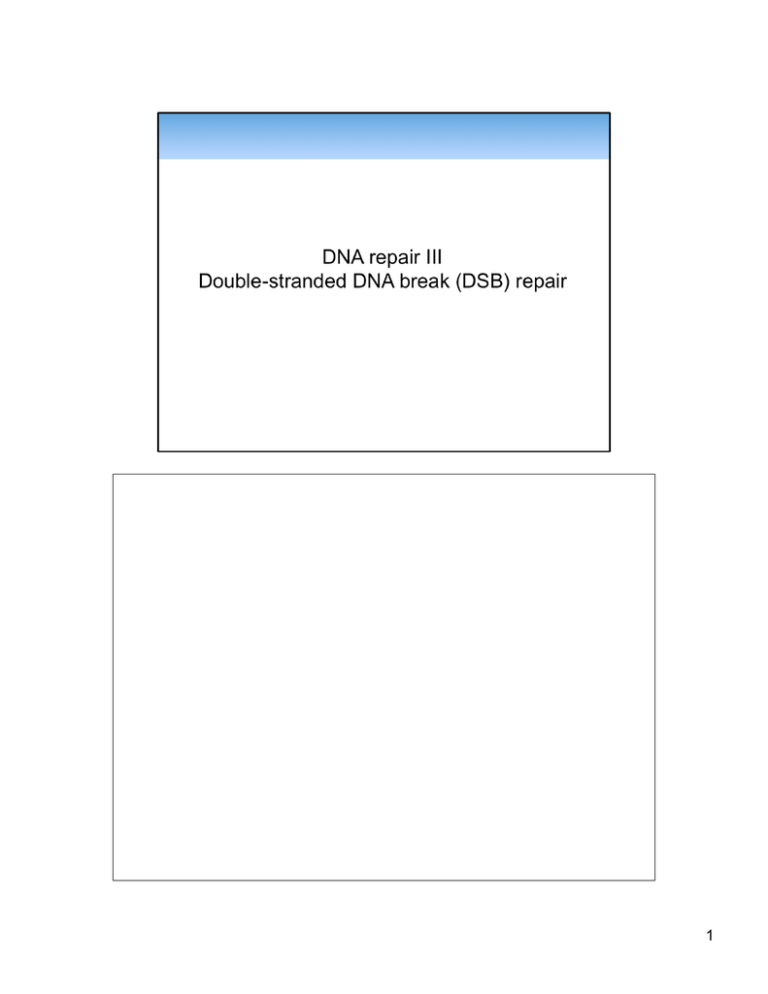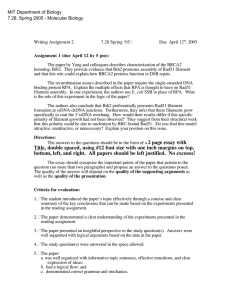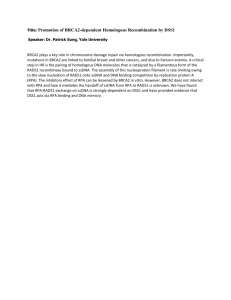6 DNA Repair III (Annotated).pptx
advertisement

1 2 So far, we talked about four types of excision repair, in which DNA damage (or misincorporated nucleo>des) are removed and the resul>ng gap filled in. We also talked about the bypass of thymine dimers using pol eta, which is a damage tolerance pathway, not a DNA repair pathway. Double strand breaks (DSBs) affect both strands, so excision repair does not work. Today, we’ll talk about two types of DSB repair, homologous recombina>on, in which the sister or homolog is used as an informa>on donor to restore the original gene>c informa>on, and non-­‐homologous end joining, in which the two ends are glued back together again without regard to restoring the original sequence, which frequently leads to small dele>ons or inser>ons. 3 DSBs are highly toxic. If repaired incorrectly, DSBs can lead to chromosomal transloca>ons, a frequent underlying cause of tumorigenesis. 4 If unrepaired they can also lead to the loss of an en>re chromosome arm. 5 There are several sources of DSBs in cells. Some are programmed, as in meiosis, where Spo11-­‐induced DSB forma>on is essen>al for homolog pairing and recombina>on between maternal and paternal genomes (see Gene>cs 201). However, many breaks represent unwanted DNA damage (aberrant). One source of aberrant breaks comes from environmental insults such as ionizing radia>on. 6 7 To prepare DSB for HR, they first need to be resected to generate a 3’ ssDNA tail that is bound by a recombinase (RecA or Rad51) to generate the “pre-­‐synap>c filament.” The presynap>c filament searches for a “homology donor” a piece of DNA that is iden>cal or nearly iden>cal to the sequence at the site of the break. Once homology is found, the recombinase catalyzes exchange with the homology donor, leading to forma>on of a D-­‐loop. The 3’end is then extended with a DNA polymerase using the homology donor as the template. In the simplest form of HR, the newly extended strand is subsequently “extruded” (disengaged from the template) by a DNA helicase and annealed to the other end of the DSB. Gap filling completes the process. 8 The simplest assay for RecA-­‐dependent strand exchange involves the transfer of one strand of linear double stranded (lds) to a single-­‐stranded DNA circle. Ini>ally, only the linear duplex is visible (because the ssDNA does not stain well with ethidium bromide). A joint molecule (jm) intermediate is formed during strand transfer, and finally, a double-­‐strandedd nicked (nc), circle appears that can be stained with EtBr. 9 The interac>on of recA with DNA was first examined by electron microscopy. The images show that recA forms a right handed helical filament on ssDNA or dsDNA, which bind to different sites in the filament. Six recA molecules are bound per turn and the rise per nucleo>de of ssDNA and dsDNA in the recA filament is 1.5 fold greater than in free B form double stranded DNA. 10 To crystallize RecA filaments in complex with DNA, the Pavle>ch lab made a “single-­‐ chain” recA (scRecA) containing 5 or 6 recA protomers all fused together. They showed that it s>ll binds to ssDNA (see gel shi[s) and that it promotes strand exchange (not shown). 11 They solved two structures (1 and 3). One of the scRecA in complex with ssDNA (#1, the presynap>c filament) and one of scRecA bound to duplex DNA a[er strand exchange has occurred (#3, the post synap>c structure). As expected, the single stranded DNA and dsDNA in both structures was stretched to 1.5X the length of B form DNA, but stretching was non-­‐uniform: triplets with normal rise were separated by gaps with a much larger rise per basepair (7-­‐8 Angrstroms). Although there’s no structure for the intermediate complex where dsDNA has bound to the secondary binding pocket in scRecA (#2, hypothe>cal model), the homology donor here is also stretched as shown by previous electron microscopy studies, but the stretching is probably uniform. As a result, all the bases become unstacked and the duplex is unstable. In addi>on, recA holds onto one strand more than the other, libera>ng one strand for sampling by the invading ssDNA. Once homology is found, the strand moves from the donor to the invading ssDNA, forming the new “heteroduplex” (so named because HR some>mes occurs between non-­‐iden>cal sequences) in the post-­‐ synap>c complex (#3). ATP hydrolysis leads to release of the displaced strand and the new heteroduplex, but hydrolysis is not actually required for strand exchange. 12 More schema>c view (with correct colors). 13 Here’s a movie of strand exchange by RecA, based on the crystal structure from Nikola Pavle>ch. 14 15 The eukaryo>c counterpart of RecA is called Rad51, which is structurally very similar to RecA. Rad51 catalyzes the same reac>on as RecA in vitro, albeit much less efficiently. This suggests that some co-­‐factors might be required for eukaryo>c recombina>on. 16 There are many mediators of recombina>on in eukaryo>c cells, and we will discuss the characteriza>on of one of these, BRCA2, which is a suppressor of hereditary breast cancers. We’ll explore how experiments using diverse approaches culminated in a model of how BRCA2 promotes HR. 17 One of the first clues to the func>on of BRCA2 came from a two-­‐hybrid screen which showed it interacts strongly with Rad51. 18 Another clue came from the subcellular localiza>on of Rad51. When cells are treated with ionizing radia>on, which causes double-­‐stranded DNA breaks, Rad51 forms “foci” in nuclei, which are visible by immunofluorescence. It is assumed that these foci represent sites of DNA repair because the Rad51 co-­‐localizes with other puta>ve repair factors. Strikingly, in the absence of BRCA2, Rad51 fails to form foci, sugges>ng BRCA2 might be involved in recruitment of Rad51 to sites of DNA damage. 19 Given the connec>ons with Rad51, people asked whether BRCA2 deficient cells are sensi>ve to different types of DNA damage. It turns out they are sensi>ve to ionizing radia>on and other drugs that induce dsDNA breaks, but not to other agents such as UV light, which suggests a func>on in DSB repair, possibly via homologous recombina>on. However, from this data alone, BRCA1 could also be involved in NHEJ. 20 To look more directly at a possible role for BRCA2 in HR, Maria Jasin’s laboratory developed a clever in vivo assay that looks for the restora>on of the GFP open reading via homologous recombina>on. They generated a reporter construct containing two non-­‐func>onal copies of the GFP gene (in a direct repeat orienta>on, thus “DR-­‐GFP assay”). The 5’ copy contains a site for the restric>on enzyme I-­‐SceI (whose recogni>on sequence is so large that I-­‐SceI does not cut anywhere else in the genome). The I-­‐SceI site introduces two stop codons into the GFP open reading frame. The 3’ copy of GFP is truncated but otherwise normal. This reporter construct is integrated into the chromosomes of a host cell, but it cannot make func>onal GFP. Next, I-­‐SceI is expressed in the cells, which leads to the forma>on of a dsDNA break in the 5’ GFP gene. If the dsDNA break is repaired via HR with the 3’ gene (either intrachromosomally or interchromosomally with the sister chroma>d, as shown), a WT copy of GFP is restored, the cells express GFP, and turn green. NHEJ will not fix the ORF. To quan>fy the rela>ve efficiency of HR, a cell popula>on is subjected to FACS analysis and GFP posi>ve cells are quan>fied. 21 Here’s a simpler representa>on of the DR-­‐GFP assay. 22 Valida>on of the assay. In WT cells, I-­‐SceI causes a large increase in GFP posi>ve cells (GPCs; compare panels I and II). In cells lacking Rad51 (actually a Rad51 “paralog” called Xrcc3), the induc>on is greatly reduced (II vs. IV). 23 In cells lacking BRCA2, I-­‐SceI-­‐induced GFP posi>ve cells are 6-­‐fold less abundant than in WT cells, showing that BRCA2 is required for efficient HR. 24 A detailed structure-­‐func>on analysis of BRCA2 revealed a number of domains, including eight, short, 30 amino acid “BRC” repeats, each of which is sufficient to bind Rad51 (accoun>ng for the posi>ve two hybrid screen). Another interes>ng domain was the OB fold (of which there are three), which binds to ssDNA. As an aside, most proteins that bind single-­‐stranded DNA, such as RPA, do so using an OB fold. 25 A full understanding of what effect BRCA2 has on Rad51 was delayed for many years because nobody could purify the protein. In the last few years, three groups succeeded. All of them fused the protein to a large tag (maltose binding protein, glutathione S transferase, or green fluorescent protein), which likely helped solubilize the protein. All proteins were also expressed in eukaryo>c expression systems. 26 Consistent with BRCA2 containing an OB fold, it binds specifically to ssDNA in gel shi[ assays. 27 How does BRCA2 do its job? Kowalczykowski’s lab used “pull-­‐down assays” to show that the full length BRCA2 can bind to Rad51. That is, when they mixed BRCA2 and Rad51, recovering the BRCA2 via its maltose binding domain via amylose resin led to co-­‐recovery of Rad51 (lanes 5-­‐10). To determine how many molecules of Rad51 bind per molecule of BRCA2, they performed “quan>ta>ve Western blolng” in which moles of recovered material (in lanes 5-­‐11) is determined by comparison with a dilu>on series of known amounts of the relevant proteins (lanes 1-­‐4 for Rad51 and 12-­‐14 for BRCA2) applied to the same gel. Plolng the data (f) showed that up to 6 molecules of Rad51 bound per molecule of BRCA2. This is consistent with the presence of mul>ple BRC repeats in BRCA2. 28 To determine how BRCA2 affects the mechanism of HR, Jensen et al. used a strand exchange assay in which a 3’ overhang invades a 40 bp duplex, of which one strand is radioac>ve. Strand exchange is detected by virtue of the radioac>ve strand moving to a slower mobility. Using this assay, they first showed (as others had before) that Rad51 promotes strand exchange (compare lanes 1 and 4). They also found that if they pre-­‐mixed the DNA template with RPA before addi>on of Rad51, strand exchange was blocked (lanes 5-­‐7, le[ gel). However, if they added BRCA2 before the addi>on of Rad51, the inhibitory effect of RPA was neutralized. Therefore, BRCA2 is able to counteract the inhibitory effect of RPA on Rad51 ac>on. 29 To determine how BRCA2 affects the mechanism of HR, Jensen et al. used a strand exchange assay in which a 3’ overhang invades a 40 bp duplex, of which one strand is radioac>ve. Strand exchange is detected by virtue of the radioac>ve strand moving to a slower mobility. Using this assay, they first showed (as others had before) that Rad51 promotes strand exchange (compare lanes 1 and 4). They also found that if they pre-­‐mixed the DNA template with RPA before addi>on of Rad51, strand exchange was blocked (lanes 5-­‐7, le[ gel). However, if they added BRCA2 before the addi>on of Rad51, the inhibitory effect of RPA was neutralized. Therefore, BRCA2 is able to counteract the inhibitory effect of RPA on Rad51 ac>on. 30 Together, the data suggest a model in which BRCA2 facilitates Rad51 mediated strand exchange by assis>ng Rad51 in the compe>>on with RPA. To this end, BRCA2 binds mul>ple Rad51 molecules (enough to nucleate a filament). BRCA2 delivers its Rad51 cargo to single stranded DNA via its ssDNA binding domain (OB-­‐fold), allowing assembly of the Rad51-­‐ssDNA filament. 31 32 So far, we’ve discussed HR only in the context of two-­‐ended double-­‐stranded DNA breaks. However, the most commons source of DSBs, and what probably provided the driving force for evolu>on of HR, is the one-­‐ended DSB that arises during replica>on fork collapse. The most common source of such collapse events is probably when a DNA replica>on fork encounters a nick in the template strand. 33 Note that in the context of a one-­‐ended DSB, second-­‐end capture does not work as there’s no second end to capture! Instead, the displaced strand of the D-­‐loop becomes the lagging strand template for the re-­‐established DNA replica>on fork. However, now there exists a cross-­‐over structure between the sister chroma>ds called a Holliday junc>on which must be resolved before the cell can divide. This resolu>on is performed by a so-­‐called Holliday junc>on resolvase which cuts the junc>on as indicated by the horizontal blue arrows. As shown, the final structure is a non-­‐crossover product, because the chromosome arms have not been exchanged. 34 35 There’s a second way of culng these junc>ons (ver>cal blue arrows), which will give rise to a “cross-­‐over product,” in which the arms are exchanged. 36 The other way to fix a DSB is through non-­‐homologous end joining. In this mechanism, which does not require a homology donor, the Ku70/Ku80 heterodimer binds ends first and protects them from resec>on. It also recruits the cataly>c subunit of the DNA dependent protein kinase (DNA-­‐PKcs). Together, DNA-­‐PKcs and Ku form the DNA-­‐PK holoenzyme, which phosphorylates mul>ple proteins near the break. A complex of DNA ligase IV and XRCC4, and an XRCC4 like factor (XLF) then bind the ends and promote liga>on. In a collabora>on with us (in prepara>on), a student in Joe Loparo’s group has shown that DNA-­‐PK brings the two DNA ends into the general vicinity of each other (“Long-­‐range synap>c complex”) whereas XLF and DNA ligase IV are required to bring the two ends into close alignment (short range complex). If the ends are compa>ble and not damaged, liga>on takes place. If the ends are damaged or incompa>ble, they are processed by different nucleases and polymerases to prepare them for liga>on. These processing events can be mutagenic. 37 Finally, let’s talk about when cells use NHEJ vs. HR. First some nomenclature: Diploid organisms contain two copies of each chromosome called homologs, a maternal copy inherited from mom, and a paternal copy inherited from dad. Except for some allelic differences, homologs are iden>cal. In S phase, each homolog is replicated, giving rise to two sisters, which are iden>cal (barring replica>on errors) and held together by sister chroma>d cohesion. Homologs are generally not good homology donors for each other because they are not close to each other in the nucleus. Therefore, in G1, NHEJ is the only DSB repair pathway. (The excep>on to this is meiosis, when there is recombina>on between homologs). In S and G2 phase, when a sister is available, HR becomes a prominent pathway, although NHEJ is also s>ll ac>ve. When a replica>on fork collapses into a one-­‐ended DSB, NHEJ can’t fix the damage because it’s a one-­‐ ended DSB with no second end to join with. Recombina>on between sisters is the only means of repair. Since replica>on forks frequently collapse, HR is essen>al in dividing cells, even in the absence of exogenous DNA damage, and it’s thought that the reason why HR arose in evolu>on was to fix replica>on errors. Indeed, Rad51-­‐ deficient cells are not viable. 38 39

